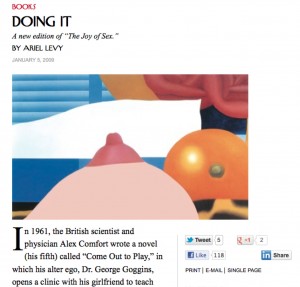I originally thought I would title this post: “Does Anyone at the New Yorker Actually Know How to Read?” but decided that was slightly too inflammatory. But I’m still baffled at this 2009 post, which I recently stumbled on over there:
It’s not the article itself that’s the problem—that at least is a readable and informed look back at the British physician Alex Comfort and his landmark 1972 book The Joy of Sex. The pretext for this article is the release of a new edition of The Joy of Sex, and there’s a good deal of ‘then and now’ stuff in it, leading up to the predictable conclusion that The Joy of Sex has been largely supplanted both by its own success as an educational manual (“What was revolutionary in 1972 seems obvious now”) and by the internet, our collective library of erotica and porn past and present.
Along the way, author Ariel Levy rightly criticizes The Joy of Sex for its—how do I put this without using words like heteronormative or phallocentric?—well, for what she flags as “the feel of a penis propaganda pamphlet.” She goes on to mention the “feminist alternative” to Joy of Sex, the Boston Women’s Health Book Collective’s Our Bodies, Ourselves, which was published a year before The Joy of Sex. Together and separately, these two books changed the terms of debate about sexuality in America by directly attacking the culture of misinformation surrounding it.
And this is why I’m still scratching my head. Here is an article written at a moment when women in America are having to refight many of the very same issues of the 1970s that prompted these two books—control over one’s own body, right to abortion, freedom from reflexive victim-blaming in rape cases, normalization of plastic surgery, to name just a few. And even as the author clearly respects The Joy of Sex as a mass education project, she also calls out Comfort for his various blind spots (homosexuality, for one). So what is the thumbnail image that accompanies this essay? In case you skipped right over it as one so often does with this kind of graphical window dressing:
Yep. In close-up. You might almost say, objectified.
I recognize the style: it’s either a Tom Wesselmann painting or a pastiche of one. I’d guess it’s the latter since reverse-image look-up doesn’t lead to any other versions of this image on the web other than those leading back to the New Yorker. And even more because the image itself is both uncredited and unlinked.
Wesselmann made his name as a Pop artist in the 1960s with a series called “The Great American Nude.” Here is a Wesselmann painting from that era that give a sense of his signature style:
Feminists have long had a problem with Wesselmann’s work—the eyeless, supine naked women, the fixation on erogenous zones and detached body parts. At the very least this thumbnail is a puzzling choice to accompany an article about two books whose goals included, among other things, helping women to stop seeing themselves as a bunch of body parts intended solely for male pleasure. Way to undercut your own essay, guys. (Unless I’m missing some kind of twee irony here, which I certainly hope is not the case.)
So this is how I found myself wondering about the reading comprehension of the website’s art designer—or perhaps, this being the New Yorker, there is actually an entire Department of Thumbnail Iconography that makes these decisions at weekly closed-door meetings. Whoever it was, I suspect they may have leapt on this one sentence as the key to picking an accompanying image:
“The Joy of Sex redux becomes generic—Cook’s Illustrated with boobies.”
With boobies, indeed.


